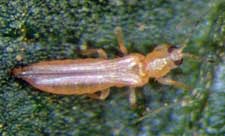Developing a virus reduction strategy for cucurbits
Most vegetable crops are susceptible to virus diseases, especially cucurbit crops. Understanding the virus cycle and planning can reduce economic loss.
Cucurbit crops (squash, pumpkin, watermelon, cucumber, cantaloupe and others) are especially susceptible to viral diseases. Infection affects foliage and fruit (Photos 1 and 2) and potentially leads to significant economic loss. To minimize loss, it is helpful to understand the virus cycle.


Photos 1 and 2. Squash infected with squash mosaic virus. Photos: David B. Langston, University of Georgia, Bugwood. org (left) and Alton N. Sparks, University of Georgia, Bugwood.org (right)
How do plants get infected? Few viruses are passed on from parent to offspring in the seed; however, many viruses can be transmitted from the female parent to the offspring on the outside of the seed. Therefore, it is important to obtain seed from a reliable source that has production and testing procedures that minimize and detect infections.
Virus can also be transmitted mechanically by getting sap from infected plants onto hands and cultivating and harvesting equipment (knives) and then carrying it to non-infected plants. Workers who use tobacco products need to sterilize their hands before handling plants. Harvesting knives should be sterilized between fields, at the end of each row, or more often if an infection is identified in a field. Cultivating equipment should be power-washed and allowed to dry between fields. For more information on the cleanliness of harvest knives, see the Michigan State University Extension article, “Can you improve the cleanliness of your harvest knives?”
The main means of virus transmission is through insect vectors, primarily thrips, leafhoppers and aphids (Photos 3-5). These insects feed on infected plants, pick up the virus, move to a healthy plant and feed on it, transmitting the virus in the process. Viruses are either persistent or non-persistent in the vector. Persistent viruses remain active in the vector, allowing it to transmit the disease throughout its life. Non-persistent viruses have limited life outside the plant host and if the vector does not feed on a susceptible plant, the virus dies. Since insecticides work on aphids after they have fed, controlling aphids is not helpful in controlling aphid-vectored viruses.



Photos 3-5. Western flower thrip (left), potato leafhopper (middle) and green peach aphid (right). Photos: Frank Peairs, Colorado State University, Bugwood.org (left); Steve L. Brown, University of Georgia, Bugwood.org (middle); David Cappaert, MSU, Bugwood.org (right)
Thrips can transmit tomato spotted wilt virus (TSWV) to transplants while they are in the greenhouse. In northern greenhouses, TSWV is often acquired from a floral crop, so it is best to separate flowers and vegetables in different greenhouses. Even this may not be enough since thrips can hitch rides on workers clothes. Controlling perennial weeds, which are the initial sources of many viruses around the greenhouse and production fields, may help reduce virus transmission.
Aphid-vectored viruses become more of a problem later in the season after aphid populations increase. Aphids overwinter as eggs and it takes time for the population to increase, acquire virus from perennial weeds and then transmit it to economic plants. Therefore, virus damage generally does not occur until mid- to late July in Michigan. Breeders have developed varieties tolerant to many of the more common virus diseases and growers should use these varieties in plantings that will be present when aphid pressure is high. Virus symptoms only appear on that part of the plant forming after infection occurs. Early plantings of crops like pumpkins and fall squash will often set and mature marketable fruit even if the plant becomes infected. Leafhoppers move north with the season, so viruses they vector might also appear later in the season after the population increases.
Virus symptoms on foliage can often appear similar to herbicide damage. For help in proper identification, contact your local MSU Extension county office.



 Print
Print Email
Email



